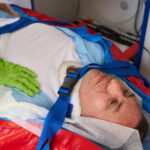EDITOR’S NOTE:
Dr. Nirav Kamdar is the vice president of quality and clinical operations at Huntington Health-Cedars-Sinai Health System in Los Angeles. Dr. Kamdar is representative of the new breed of relatively young physicians serving America’s healthcare needs.
BUCK: Tell me, what events or circumstances led you to become a doctor?
NK: I was a child of physicians, and they were very encouraging (basically insistent) of me pursuing a life and career that was far different than their own.
Family dinner conversations were always heated discussions about politics, Senate bills, and even local ballot measures. So, I prepared myself to be working in government and foreign policy. I studied political science and public policy, and did my post-graduate work in grassroots peacebuilding efforts just outside Geneva, Switzerland.
Most of the peace efforts and negotiations that I was doing came down to two major issues: 1) access to healthcare resources and 2) sanitation. When I came back to the United States to do my graduate work in health policy, I realized that there was a large gap between how policy formulators thought about healthcare delivery, compared to frontline practitioners. I felt I needed to try to bridge both sides. So, as a rebellious late 20-year-old, I applied to medical school to bridge the language gap…and here I am with my MD.
Medicine is such a versatile career path. At its core and Oslerian roots, there is no greater privilege, altruism, and even philanthropy than helping an individual in need.
Yet this career can go from one person, one patient, to organizing groups, organizations, systems, research, and even nation-state stabilization. The career allows you to be both data nerd, critical thinker, and at the same time, a humanitarian.
BUCK: When you were in med school, what subjects captured your imagination?
NK: Physiology and pathophysiology just made sense to me. I was not a memorizer, but rather I was better at visualizing pathways and where there could be forks in the road. So, anesthesia and critical care were good fits for my cognitive passions.
Thoracic anesthesia in particular is very dynamic, with severe changes in physiology when you use one-lung ventilation, with extreme changes in coupled cardiac physiology with different patient positions in the operating room (OR). The patients are often very sick, with complex cancers, and there are always some sheer terror moments. I live for that.
Also, my personality type is that I am an extreme extrovert, and I love meeting strangers. In fact, outside of work, I like to host live-music concerts in my home, and I just invite a house full of strangers to meet, congregate, and enjoy a live music set or a chamber music salon.
So, anesthesia lets me repeat that type of extroversion with a new patient and new family every few hours, gain their trust very quickly, and then I can do my thing with the science and physiology thereafter.
BUCK: Today you’re the vice president of quality and clinical operations at Huntington Health-Cedars-Sinai Health System in Los Angeles. Is this position something to which you aspired as a student in medical school?
NK: I was always interested in how systems work and (are) put together. Quality improvement with models such as the IHI (Institute for Healthcare Improvement) model of improvement and Lean methodologies are always geared towards thinking about systems thinking. I mentioned that I liked physiology, and medicine is filled with positive and negative feedback loops. Well, healthcare systems are filled with those too! So, I like thinking about process improvement with the perspective of physiology: 1) how do you keep key performance moving forward; 2) what are the negative feedback loops; 3) what is the equilibrium; 4) can Le Chatelier’s Principle apply to people, rather than just proteins and enzymes?
BUCK: What advice do you offer for other young people who might be considering a career as a doctor?
NK: Look at approaching medicine as a lifelong student. Medicine is just a massive ocean – nay, galaxy – of information, which is constantly changing and expanding. Mastery takes lifetimes, and so you need to love the process of learning new things. The learning doesn’t just end with disease, pharmacology, and therapy. There are so many avenues to learn about: underground trap doors, secret passageways, and characters or protagonists, in the funhouse of this career. Just when patient care is burning you out, explore the ethics of healthcare delivery and the financial conundrums; go research or invent something that will make a difference to patients. When the business of medicine makes you melancholy, go back and see patients and feel that soul food re-energize you.
Also, use your clinical rotations to figure out a good fit of career to match your personality (both cognitive and physical abilities). Be very cognizant if you are a morning person or a night owl; if you like long-term patient relationships (like primary care and psychiatry) vs. short-term patient relationships (pathology, radiology, anesthesiology, emergency medicine).
There really is something for everybody.























